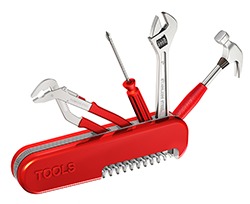Progress Scoring (Part 2) … Designing Sales Tools

Sales Progress Scoring was introduced in our last post (Progress Scoring – “But … we don’t forecast that way!”), and continues here with part 2, Designing Sales Tools.
Sales tools can be standard or custom content, of various types:
– Product focus – Standard – General product spec sheets, webpages, PDFs, and brochures
– Business focus – Standard – Application notes, testimonials, generic payback analysis
– Specific Project focus – Custom – User Problem description (using their cases and terminology), Application/solution description (placed in their context), Payback analysis (using their metrics) – All focused on a specific opportunity project approval (…the best type of sales tools, yet they take a bit more time to create)
Resistance to new B2B sales tools and techniques is common – Why?
Customized sales tools are the best, so the next question is “Why doesn’t everybody in B2B sales use them?” Resistance is common in all businesses. Sales individuals have several things standing in their way. First, the customer does not ask for these things. Second, the customer asks for standard “Product” info, which invites you into an “activity trap”. Lastly the sales person may feel a bit lazy, and just agree to provide only the standard Product info.
Designing the first few versions of a custom sales tool is hard work. Sales management has to strongly support the idea of creating these new tools, and give it management focus. My recommendation is to select a sales or marketing person to do it, and just get it done, using current active opportunities as test cases.
Problem statements are a good place to start, with standard “Application notes” as a starting point to identify typical needs and typical metrics. Then customize. Clarity and relevance can be added by laying out a document that enables selection of key points that arise for a particular buyer company. The tool should also allow tailoring the prose to fit the terms used at that company. The buyer needs to feel at home reading it. Otherwise it is just boilerplate, and they won’t read it!
The best proof points to build into your proposals are business case proofs. The “proof” does not have to be a hard ROI calculation, but must include measurable items – e.g. systems for an engineering group need to be set in a context of scope, with facts like:
– Customer organization has XX engineers employed – thus rough cost/year is $CC
– Annual projects impacted by engineering is = $YY millions (= $RR/months of revenue)
– Annual turnover of talent is TT% – and goal is to reduce that to tt%
Sales Tools clarify insights about customer Pain, Payback, and Urgency
In general, sales tools should cover the three areas on which successful proposals are scrutinized before winning senior management approval (ref our webinar “Speeding up Sales”):
– Does it solve important problems for this business? (…not just nice to have)
– Does it show a financial or strategic payback that starts in the short term after implementation?
– Urgency? – Is the champion well prepared to argue why this year’s business plan needs the purchase you are proposing, and needs it now?
Present samples of your custom sales tools to the sales team in a mini training session, and get their critiques and inputs. Then the sales manager needs to be sure they are used for at least 3 opportunities. This gives the sales professional a chance to experience customer reactions, and increased deal-closing success.
In the next section (part 3) we will move on to cover sales process design – as a foundation for sales progress scoring.



Follow Us
Follow us on LinkedIn for updates.